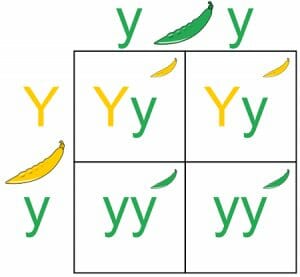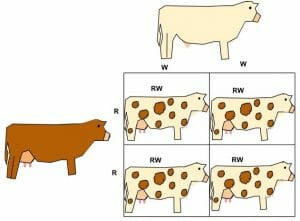Dominant Allele Definition
A dominant allele is a variation of a gene that will produce a certain phenotype, even in the presence of other alleles. A dominant allele typically encodes for a functioning protein. The allele is dominant because one copy of the allele produces enough enzyme to supply a cell with plenty of a given product. Some traits rely on a product being created, like pigment molecules for hair color, ion-channels for proper cell function, and other traits that rely on a functioning enzyme. Other traits rely on the lack of an enzyme, or an enzyme that is not functioning efficiently. The lack of the product of the enzyme creates an entirely different phenotype.
When a dominant allele is completely dominant over another allele, the other allele is known as recessive. However, there are also situations of incomplete dominance and codominance. In incomplete dominance, two dominant alleles can mix to create a third phenotype, a sort of mix between two phenotypes. Think of a white and red flower alleles mixing in a heterozygote to produce a pink flower. In codominance, different alleles are expressed in different areas, creating unique pattern. Think of codominance as the spots on a cow.
To describe an allele as a dominant allele, you must reference another allele. Dominant and recessive are just descriptions of a relationship between alleles. Some alleles of a gene compete differently with different alleles. They may be dominant to one allele, and recessive to another. It all depends on the protein they create, how those proteins interact with each other, and how the entire system interacts with the environment. While most simple examples given are of purely dominant/recessive relationships, in reality the interactions are much more complex.
Types of Dominant Allele
Complete Dominance
In cases of complete dominance, a dominant allele complete hides the effects of a recessive allele. This can only be seen in heterozygous individuals. Homozygous dominant individuals have two dominant alleles, which produce the same enzyme. In homozygous recessive individuals, no dominant allele is present, and the phenotype only reflects the action of the recessive alleles. In the heterozygous individual, the phenotype appears to be the same as in the homozygous dominant individual. This is the defining feature of complete dominance; the dominant allele completely hides the presence of the recessive allele to the observer.
This can be seen in pea plants, in the color of their peas. The dominant allele produces a yellow pigment through the enzyme it codes for. One allele is sufficient to produce enough yellow pigment to make the entire plant look yellow. The green allele produces a non-functional enzyme, and no yellow is created in a homozygous recessive plant. The yellow allele is dominant to the green allele, and the green allele recessive to the yellow allow. The picture below shows the cross between a heterozygous individual on the left, and a homozygous recessive individual on top.
Incomplete Dominance
Incomplete dominance is a case where dominant alleles produce different enzymes, but one allele does not overwhelm the other in the phenotypic expression. Both alleles are considered dominant alleles, in relation to each other, and produce an equal amount of effect physically. In some flowers, this effect can be seen dramatically in heterozygous individuals. Below is the Punnett square cross of two flowers that display incomplete dominance.
The red flowers have two copies of the red allele. This gives allows them to produce enough red pigment to make a deeply red color. The allele that produces white flowers creates a non-functional allele. Without its red color, the flower appears white in individuals with two white alleles. However, the red allele is not dominant over the white allele because in the heterozygous individual the flowers are pink, not red. Incomplete dominance effects many different enzymes, and not just the ones that control things we see. Oftentimes incomplete dominance is responsible for different organisms producing high levels, medium levels, and low levels of certain substances.
Codominance
In codominance, the dominant alleles are both expressed, but they are segregated from each other in which areas they are expressed. This can be easily seen in cattle. In the following picture, cattle have two codominant alleles: red and white. A cow with two red alleles is only red, and a cow with only white alleles is only white. However, a cow with both alleles will display red and white patches all over its body. The picture is a little misleading, because the distribution of spots would be random on the cows, and they would each look unique.
Which gene gets activated is determined during development, and different alleles get activated in different areas based on chance and the signals being sent out by the developing body. Codominance is responsible for the great variety and patterns seen in different animals, especially dogs and cats. Because dogs and cats have been artificially selected to produce a wide variety of coats, there are many alleles that exist in codominance with other alleles in the population.
Related Biology Terms
- Codominance – When two dominant alleles are expressed separately, in different areas of an organism.
- Incomplete Dominance – When two dominant alleles are expressed equally, in every cell.
- Recessive Allele – An allele that is completely masked phenotypically by a dominant allele.
- Genotype – In sexually reproducing organisms, the set of two alleles that determine the phenotype of an organism.
Quiz
1. A heterozygous fruit fly has two alleles for wing development. One allele is for the “wild-type”, functional wings, and the other is a mutated allele that produces shriveled wings. The fruit fly has fully functional wings. What type of dominance is this?
A. Complete Dominance
B. Codominance
C. Incomplete Dominance
2. One lab rat is homozygous for the allele that creates black fur. Another rat is homozygous for the allele that creates yellow fur. They have a litter of little rat pups. All of the pups are dark yellow. What type of dominance is this?
A. Complete Dominance
B. Codominance
C. Incomplete Dominance
3. Huntington’s disease is a genetic disorder that is expressed through complete dominance over other alleles. If one of your parents has Huntington’s disease, and the other does not, what is the chance that you will get Huntington’s?
A. 25%
B. 50%
C. 100%



